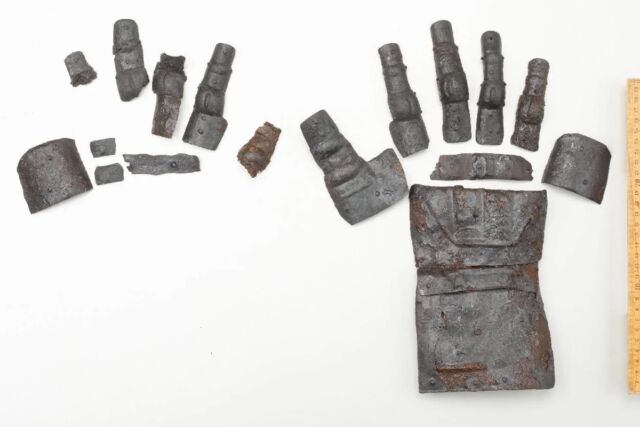Did Thanos drop something? —
The team also unearthed fragments of the glove’s companion, worn on the opposite hand.

Canton of Zurich
Archaeologists announced this week that they have discovered an intact 14th-century medieval gauntlet during excavations around Switzerland’s Kyburg Castle—a rare find, given that only five other gauntlets from this period have been found in the region to date. It’s remarkably well-preserved, with many design and decorative details clearly visible. The team also unearthed fragments of the glove’s companion, worn on the opposite hand.
The origins of Kyburg Castle date back to around the late 10th century, with the first mention occurring in 1027 under the name Chuigeburg (translation: “cows-fort”). That suggests it was originally used to house livestock. The Holy Roman Emperor Conrad II destroyed that early fortification sometime between 1028 and 1030, but it was rebuilt and became a possession of the counts of Dillingen. It was partially destroyed again in 1079 as Pope Gregory VII and Henry IV (who would later become Holy Roman Emperor) engaged in a bitter conflict over which of them had the power to install bishops, monastery abbots, and even the pope himself (known as the Investiture Controversy).
That conflict didn’t resolve for a good 50 years, but Kyburg Castle endured, and by the 13th century, the counts of Kyburg (descendants of the Dillingen family) were among the most powerful noble families in the Swiss plateau. Kyburg Castle is one of the largest surviving castles in Switzerland, with its existing core dating back to the 13th century. In addition to the tower and great hall, there are several residential and commercial buildings as well as a chapel, all connected by a ring wall that encloses the courtyard. It has belonged to the Canton of Zurich since 1917 and is currently run by the Verein Museum Schloss Kyburg.

Canton of Zurich
During the winter of 2021 and 2022, the archaeologists were excavating the area just southeast of Kyburg Castle in response to the discovery of a medieval weaving cellar, found during the construction of a new house. The cellar had been destroyed by fire sometime in the 14th century, and the team concluded that a blacksmith likely made use of the cellar, since researchers found about 50 metal objects on site: hammers, keys, and projectile points, in particular. But the intact gauntlet and the fragments of its twin were the most exciting and relevant finds.
The use of hand protection in battle dates back to the late 12th century, when the mail sleeves of knights’ mail vests (hauberks) were extended into something akin to a mitten, designed to be worn over a leather glove and including some mail to protect the fingers. Mail gauntlets with separated fingers appeared in the early 14th century, featuring plates that overlapped around finger and thumb joints, although only the thumb plates were articulated. The design evolved again in the late 14th and early 15th centuries to include more articulated plates attached to mail or leather gloves.
The latter is the style of the newly discovered gauntlet. It’s a right-hand glove with four fingers. The individual plates are stacked like scales and held into place with rivets. Additional rivets on the inside were used to attach the plates to the base material (likely leather), and this in turn was sewn onto a fabric finger glove. This is fairly intricate craftsmanship, judging by the still-visible manufacturing and decorative details.
Kyburg Castle will display a copy of the gauntlet as part of its permanent exhibition, along with a reconstruction of the rest of the armor the owner would have worn along with it. The original will be displayed for three weeks this September. In the meantime, archaeologists will set about learning more about who the gauntlet belonged to and hopefully determine why such finds are so rare. It’s possible that such metal objects were melted down and recycled rather than being preserved, but until more such gauntlets are found, it is difficult to reach a definitive conclusion.